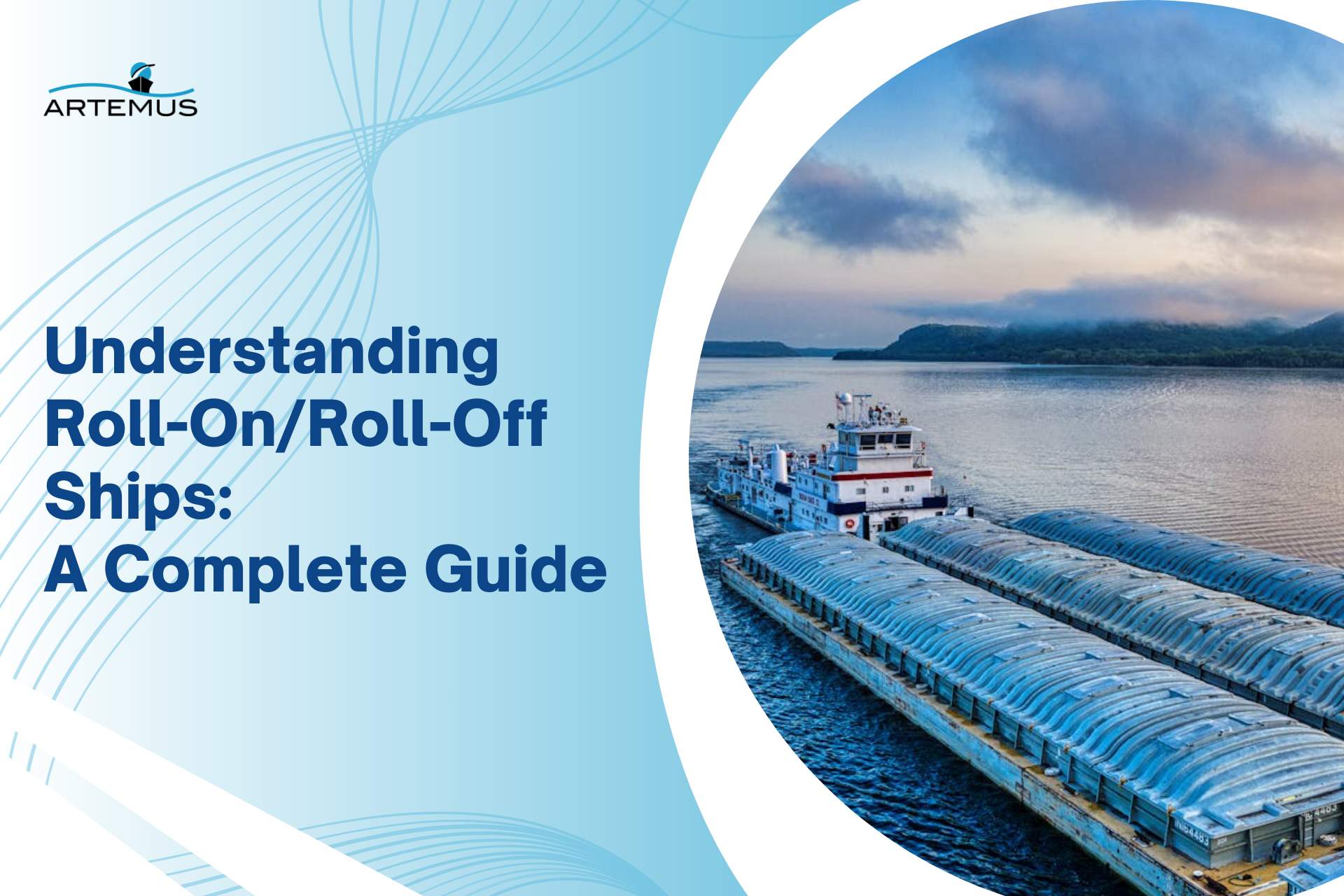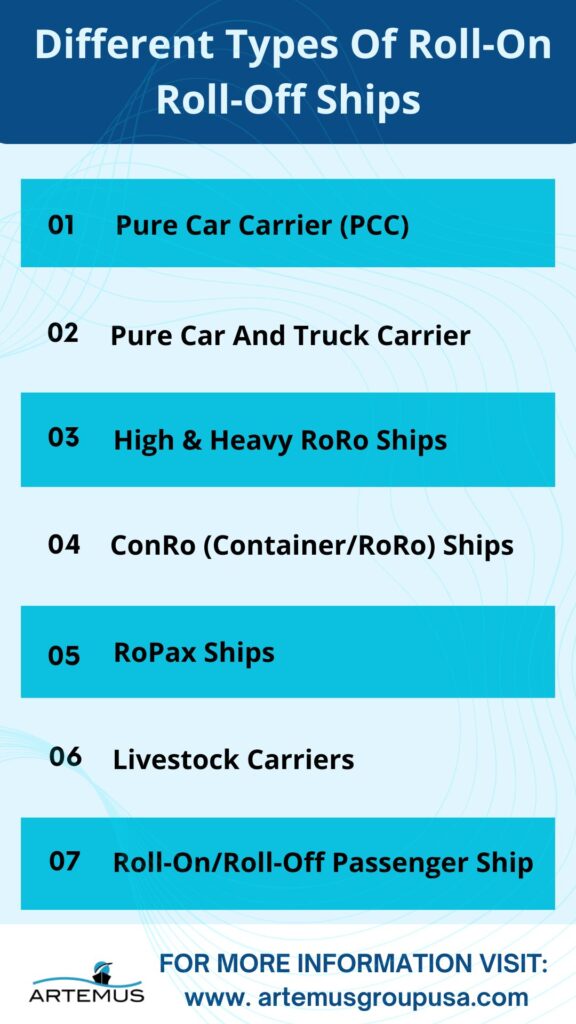
What Does Canada Export To USA? A Complete Guide
What Does Canada Export To USA? This question is key to understanding one of the most important trade relationships in

Roll-on/Roll-off (Ro-Ro) ships are specialized vessels designed for transporting wheeled cargo such as cars, trucks, trailers, and other vehicles. Unlike traditional cargo ships, Ro-Ro vessels allow vehicles to be driven on and off the ship using ramps, making the loading and unloading process faster and more efficient.
This unique design is crucial for industries that rely on the swift and safe transportation of vehicles across the globe.
At Artemus, we offer specialized software solutions for freight forwarders. The software streamlines essential filings like ISF and AMS, ensuring compliance & efficiency in every shipment.
Table Of Contents
A Roll-On Roll-Off (RoRo) ship is a type of cargo vessel specifically designed to transport wheeled cargo, such as cars, trucks, trailers, and even heavy machinery.
Unlike traditional cargo ships, where goods are loaded using cranes, RoRo ships have built-in ramps that allow vehicles to be driven on and off the ship under their own power, or they can be towed if necessary.
This method of loading and unloading is not only efficient but also significantly reduces the risk of damage to the cargo, making RoRo ships an essential component in the global transportation of vehicles and machinery.
Related: Top 10 Biggest RORO Ships In The World
One of the largest Ro-Ro passenger ferries, the MS Color Magic, weighs 75,100 GT (Gross Ton) and began service in September 2007 for Color Line. Built-in Finland by Aker Finnyards, the ferry measures 223.70 meters in length and 35 meters in width, with the capacity to carry 550 cars and 1,270 lane meters of cargo.
Another notable Ro-Ro ferry with one of the highest car-carrying capacities is the Ulysses. Named after James Joyce’s famous novel, this ferry is owned by Irish Ferries and started operating on March 25, 2001, between Dublin and Holyhead.
The Ulysses weighs 50,938 GT, spans 209.02 meters in length, and is 31.84 meters wide. It can accommodate 1,342 cars and 4,101 lane meters of cargo.
Related: How Does Freight Forwarding Work? A 2024 Guide

Roll-on roll-off (RoRo) ships are specialized vessels designed to carry wheeled cargo such as cars, trucks, trailers, and other machinery that can be driven on and off the ship on their wheels.
RoRo ships play a crucial role in the global logistics chain, facilitating the transportation of vehicles and equipment across oceans with efficiency and safety. Here’s a look at the different types of RoRo ships commonly used in maritime transport:
Pure Car Carriers are RoRo ships specifically designed to transport cars. These ships have multiple decks, with adjustable heights to accommodate vehicles of various sizes.
PCCs are equipped with built-in ramps that allow cars to drive on and off the ship with ease. These vessels are often used by automotive manufacturers to transport large volumes of vehicles between production plants and global markets.
A step up from the PCC, the Pure Car and Truck Carrier is capable of transporting not only cars but also larger vehicles such as trucks, buses, and construction machinery. PCTCs have reinforced decks and larger ramps to handle heavier cargo.
These versatile vessels are a popular choice for transporting a diverse range of wheeled cargo, providing greater flexibility for shippers.
High & Heavy RoRo ships are designed to carry oversized and heavy cargo that cannot fit into standard containers or be transported by other types of RoRo ships.
This can include construction equipment, agricultural machinery, and other industrial vehicles. These ships have strengthened decks and high cargo hold clearance, allowing them to accommodate tall and heavy equipment safely.
ConRo ships combine the capabilities of both container ships and RoRo ships, making them versatile vessels for mixed cargo. They have dedicated RoRo decks for wheeled cargo, while the upper decks are equipped with container bays.
This dual-purpose design allows ConRo ships to efficiently transport both containerized goods and vehicles, offering flexibility for routes with diverse cargo needs.
RoPax ships are a hybrid between RoRo ships and passenger ferries, designed to carry both vehicles and passengers. These vessels are commonly used on short sea routes and ferry crossings, where they transport cars, trucks, and passengers between ports.
RoPax ships are equipped with comfortable passenger accommodations, alongside dedicated cargo decks for vehicles.
A more specialized type of RoRo ship, livestock carriers are designed to transport live animals. These ships are equipped with ventilation systems, feeding and watering facilities, and other necessary features to ensure the safe and humane transport of animals.
Livestock carriers play a vital role in the agricultural supply chain, particularly for the export and import of livestock.
A variant of the RoPax ship, the Roll-On/Roll-Off Passenger Ship is primarily focused on passenger transport but also accommodates vehicles. These ships are often used for ferry services, providing a convenient means for travelers to bring their vehicles along on their journeys.
Related: What Happens After Custom Clearance Completed? 9 Next Steps

Roll-on/Roll-off (RoRo) shipping offers numerous advantages, making it a preferred method for transporting wheeled cargo such as cars, trucks, trailers, and heavy machinery. Here are some key benefits:
Roll-on/Roll-off (RoRo) ships are specialized vessels designed to transport wheeled cargo that can be driven on and off the ship via ramps. The types of goods typically loaded onto RoRo ships include:
Related: What Is Harbor Maintenance Fee (HMF)? A 2024 Guide

Roll-on roll-off (Ro-Ro) vessels and traditional cargo ships serve different purposes and are designed with distinct structural features to meet their specific functions.
Related: Customs Clearance Delays In 2024: Top 10 Reasons & Solutions
Roll-on/Roll-off (RORO) shipping is a specialized method used for transporting wheeled cargo, such as cars, trucks, and heavy machinery, across the sea. It allows vehicles to be driven directly onto and off the ship using built-in ramps, making the process more efficient and less labor-intensive.
Roll-on/Roll-off (RORO) shipping is a method used to transport wheeled cargo, such as cars, trucks, and heavy machinery, across oceans.
Unlike traditional shipping, which involves packing goods into containers, RORO shipping allows vehicles to be driven directly onto and off specialized ships. This technique streamlines the loading and unloading process, making it faster and more cost-effective
Related: What Is Ocean Freight Forwarding & Its Process?
Artemus provides freight forwarders with robust software solutions designed specifically for ISF (Importer Security Filing) and AMS (Automated Manifest System) filings. The platform streamlines the compliance process, allowing freight forwarders to efficiently manage and submit the required data to U.S. Customs and Border Protection (CBP).
With real-time updates and user-friendly features, our software ensures that all filings are accurate, timely, and fully compliant with regulatory requirements.
By automating the ISF and AMS filing process, Artemus helps freight forwarders reduce the risk of costly penalties and delays while enhancing operational efficiency.
Related: Shipping From China To USA: All You Need To Know In 2024
A roll-on roll-off (RORO) ship is a vessel designed to transport wheeled cargo, such as cars, trucks, and trailers, that are driven on and off the ship using ramps. This type of ship allows for efficient loading and unloading without the need for cranes
Roll-on, roll-off” (RORO) refers to a method of shipping where vehicles or cargo are driven on and off the ship using ramps, rather than being lifted or loaded by cranes.
RoRo (Roll-on/Roll-off) shipping involves vehicles driving on and off the ship, while PCC (Pure Car Carrier) ships are specifically designed for transporting cars, with features optimized for handling high volumes of vehicles.
Roll-on/roll-off (RORO) shipping involves vehicles or cargo being driven or rolled onto and off of a vessel using ramps, allowing for efficient loading and unloading of wheeled cargo.

Roll-on/roll-off (RORO) shipping provides a practical and efficient solution for transporting vehicles and wheeled cargo. By utilizing ramps for easy loading and unloading, this method streamlines the process, reducing handling time and minimizing damage risks.
RORO shipping proves to be a versatile choice for both international and domestic transport, ensuring smooth and cost-effective movement of large quantities of wheeled goods.

What Does Canada Export To USA? This question is key to understanding one of the most important trade relationships in

In 2024, Mexico solidified its position as the United States’ top trading partner, exporting goods valued at over $505.85 billion,

Supply chain and logistics are often used interchangeably, but they serve distinct functions in the movement of goods and services.
Get In Touch
Artemus’ Software Solutions for ISF, AMS, Japan AFR, eManifest Canada, & Panama B2B filings.
Get In Touch
Artemus’ Software Solutions for ISF, AMS, Japan AFR, eManifest Canada, & Panama B2B filings.